
The Bauer Hotel is a historic five-star hotel located on the north bank of the Grand Canal in the San Marco sestiere of Venice, Italy, near the Piazza San Marco. It closed in November 2022 for renovations, with plans to reopen in 2025. [1]

The Bauer Hotel is a historic five-star hotel located on the north bank of the Grand Canal in the San Marco sestiere of Venice, Italy, near the Piazza San Marco. It closed in November 2022 for renovations, with plans to reopen in 2025. [1]
The hotel was founded in 1880 as the Grand Hotel d'Italie Bauer-Grünwald by Mr. Bauer, a director of Venice's Hotel de la Ville, and Julius (Giulio) Grünwald, an Austrian who married Bauer's daughter.
The main hotel building, facing the Grand Canal, was rebuilt from 1900 to 1902, [2] to designs by architect Giovanni Sardi in an eclectic neo-Gothic style, [3] [4] which has been described as "perhaps the most significant representative of late-nineteenth century Venetian medieval mannerism". [5]
On the southwest corner is the Canal Bar, a large ground-level terrace surrounded by a stone fretwork fence; at the corner there stands and a 3.6m tall statue of a woman representing Italy, a work of Carlo Lorenzetti. Before the hotel's construction, this was a public square called dei Felzi. [2] The hotel's site previously held a 15th-century building in the "Arabo-Byzantine" style, [3] which was demolished in 1844. [6] Some fragments of that building were incorporated into Sardi's construction. [5]
In 1930, Grünwald's heirs sold the Hotel Bauer-Grünwald to Arnaldo Bennati, a Ligurian shipbuilder. An extra floor was added on top in 1939 by Giovanni or Giuseppe Berti. [7] [5] The 7th-floor terrace "Settimo Cielo" is the highest terrace in Venice. [8]
The hotel was closed for much of the 1940s, during which time Bennati undertook extensive renovations and added an extension to the hotel in the rear, [9] facing the Campo San Moisè. The new wing was designed by Marino Meo in 1945 and completed in 1949. [10] [11] [12]
The adjacent San Moisè church, with "the busiest façade in town", contrasts with the travertine cladding and light-colored marble columns of the Bauer extension, [10] which has been called "brutally modernist in its plainness"; [13] Joseph Brodsky described the juxtaposition as "Albert Speer having a pizza capricciosa". [11]
In 1999, Francesca Bortolotto Possati, granddaughter of Arnaldo Bennati, became the chairwoman and CEO of the hotel. [14] The hotel underwent a major renovation that year, overseen by Bortolotto Possati. The 1949 wing was marketed as the Hotel Bauer, while the older section was separately marketed as the Hotel Bauer Palazzo. [9] Elliott Management and Blue Skye investments acquired the hotel through a series of debt restructuring deals between 2017 and 2019. In 2020, the Austrian real estate investment group Signa bought the hotel. [15]
The hotel closed in November 2022 for a major renovation. [1] It plans to reopen in 2025, managed by Rosewood Hotels as the Rosewood Hotel Bauer. [16] The hotel is a member of Leading Hotels of the World.
In April 2024, Signa (by that point insolvent) arranged a sale of the shuttered hotel for an undisclosed amount to German industrialist family business Schoeller Group. [17] However, the deal was stopped by Signa's primary financier, US-based King Street Capital Management, which instead assumed direct ownership of the hotel [18] and sold it in November 2024 to Mohari Hospitality and Omnam Investment Group for €300 million, [19] as work continued on renovations, with Rosewood still on board to operate the hotel once it reopens. [20]
The Bauer offers 56 suites and 135 rooms.
The hotel restaurant is De Pisis. Breakfast is served on the 7th floor terrace, the Settimo Cielo, which in the evening serves drinks and snacks. The Canal Bar is outside, at ground level, and the B Bar offers live jazz performances.
To the left of the hotel, across the Rio San Moisè, is the Palazzo Treves-Barozzi, and to its right, separated by the Calle Tredici Martiri, is the Ca' Giustinian. The hotel's main entrance is on the north, on the Campo San Moisè. On its west runs the Rio San Moisè, on which it has a boat landing. It faces the Dogana and the Salute across the Grand Canal.
For a period in the 2010s, the Bauer group operated three additional properties: the Residenza Grunwald (formerly Bauer Casa Nova), located adjacent to the hotel on the Campo San Moisè; [21] and the Bauer Palladio and the Villa F, both located on the Giudecca, facing San Marco across the Giudecca Canal.
The Bauer-Grünwald is one of the settings of Chekhov's novella An Anonymous Story (1893).[ citation needed ]
![]() Media related to Palazzo Bauer (Venice) at Wikimedia Commons
Media related to Palazzo Bauer (Venice) at Wikimedia Commons

Ca' Foscari, the palace of the Foscari family, is a Gothic building on the waterfront of the Grand Canal in the Dorsoduro sestiere of Venice, Italy.

Palazzo Labia is a baroque palace in Venice, Italy. Built in the 17th–18th century, it is one of the last great palazzi of Venice. Little known outside of Italy, it is most notable for the remarkable frescoed ballroom painted 1746–47 by Giovanni Battista Tiepolo, with decorative works in trompe-l'œil by Gerolamo Mengozzi-Colonna.

Palazzo Malipiero is a palace in Venice, Italy. It is on the Grand Canal in the central San Samuele square. It stands just across from the Palazzo Grassi Exhibition Center.

Le Zitelle, or “The Spinsters” is a church in Venice, Italy. It is part of a former complex which gave shelter to young maidens who had no dowry, and is on the eastern part of the Giudecca island. To the east of Le Zitelle, lies Il Redentore, which was constructed around the same time.

The House of Vendramin was a rich merchant family of Venice, Italy, who were among the case nuove or "new houses" who joined the patrician class when the Libro d'Oro was opened after the battle of Chioggia. Andrea Vendramin served as the sole Vendramin Doge from 1476–78, at the height of Venetian power, though in 1477 an Antonio Feleto was imprisoned, then banished, for remarking in public that the Council of the Forty-One must have been hard-pressed to elect a cheesemonger Doge. In his youth, Andrea and his brother Luca, in joint ventures, used to ship from Alexandria enough goods to fill a galley or a galley and a half, Malipiero recorded in retrospect: even his factors grew rich managing his affairs. At this period, mentions of Vendramins in various fields of business occur; Luca Vendramin (d.1527) founded a successful bank on the still-wooden Rialto Bridge with three Capelli brothers in 1507, but in his will of 1524 forbade his sons from continuing in banking. An early text on accounting mentions that the Vendramins' soap is so reliably good that you can buy it without inspecting it. Later they owned an important theatre.
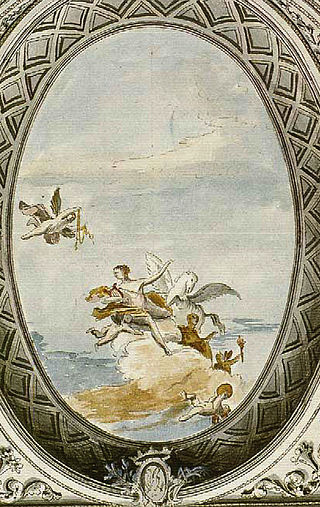
The Teatro San Moisè was a theatre and opera house in Venice, active from 1620 to 1818. It was in a prominent location near the Palazzo Giustinian and the church of San Moisè at the entrance to the Grand Canal.
René Benko is a bankrupt Austrian real estate, media and retail investor, and was the founder of the Signa Holding. The company was considered Austria's largest privately held real estate conglomerate. Benko was considered one of the richest Austrians and had very good relations with leading politicians in Austria from all parties. Numerous controversies have surrounded Benko’s professional career. In March 2024 Benko declared personal insolvency.

Punta della Dogana is an art museum in one of Venice's old customs buildings, the Dogana da Mar. It also refers to the triangular area of Venice where the Grand Canal meets the Giudecca Canal, and its collection of buildings: the church of Santa Maria della Salute,, the Patriarchal Seminary of Venice, and Dogana da Mar at the triangle's tip.

Francesca Bortolotto Possati is an Italian entrepreneur, author, interior designer, philanthropist and hotelier. She is the chief executive officer of the Bauer Hotel group in Venice, and the granddaughter of Arnaldo Bennati, a Ligurian shipbuilder who purchased the Bauer Hotel in 1930. She was the only female CEO in the city of Venice as of 2008.

The Palazzo Ferro Fini is a historical building in Venice, Italy. It was originally two buildings, the Palazzo Morosini Ferro and the Palazzo Flangini Fini, which were combined into one in the 1860s to create the luxury Hotel New York. The hotel was occupied by troops in World War II (1939–45). By 1970 the hotel was in decay, and the building was purchased by the Veneto region, which undertook extensive renovations and made it the seat of the regional council.

The Palazzo Pisani Gritti is a Venetian Gothic palazzo located on the north side of the Grand Canal, opposite the Church of the Salute, between the Campo del Traghetto and the Rio de l'Alboro, in the Sestieri of San Marco, Venice, Italy. It was the residence of Doge Andrea Gritti in the 16th century. It is now the Gritti Palace Hotel.

Palazzo Nani is a Renaissance palace in the Cannaregio district of Venice, Italy.

Palazzo Giovanelli is a palace in Venice, located in the Santa Croce district, overlooking the right side of the Grand Canal and the Rio di San Giovanni Decollato, before the Fondaco dei Turchi.

Palazzo D'Anna Viaro Martinengo Volpi di Misurata, also known as Palazzo Talenti D'Anna Volpi, is a Renaissance palace in Venice, Italy, located in the San Marco district, overlooking the left side of the Grand Canal, between Palazzo Tron and Casa Marinoni and opposite of Palazzo Donà a Sant'Aponal.
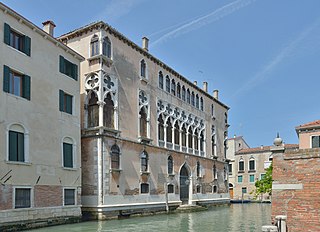
Palazzo Donà Giovannelli is a civil building located in the city of Venice, Italy in the Cannaregio district. The palace neighbors Palazzo Pasqualigo Giovannelli and overlooks the Rio di Noale and the Rio di Santa Fosca.
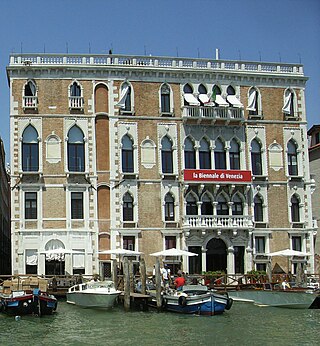
The Ca' Giustinian, sometimes called the Palazzo Giustinian, is a palace on the Grand Canal in the San Marco sestiere of Venice, Italy. It is today the seat of the Venice Biennale. Built in 1471, it was among the last Gothic palazzi built in Venice. It was partially modernized in the 17th century.
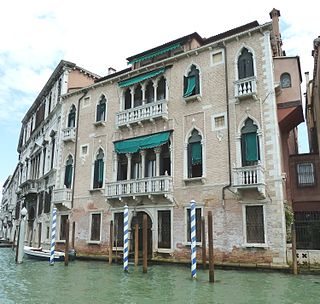
Palazzo Erizzo Nani Mocenigo is a palace in Venice located in the San Marco district and overlooking the Grand Canal between Palazzo Da Lezze and Palazzo Contarini delle Figure.

Palazzo Vitturi is a palace in Venice, Italy located in the Castello district, on the north-eastern side of Campo Santa Maria Formosa, of which the palazzo is the oldest building. The palace is mentioned in the works of Sansovino.
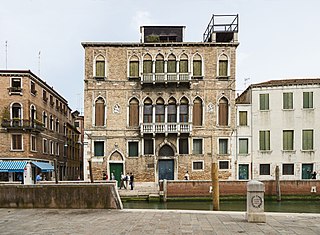
Palazzo Barbarigo Nani Mocenigo is a Gothic palace in Venice, Italy located in the Dorsoduro district, along the Nani embankment on the San Trovaso canal, near the Campo San Trovaso.
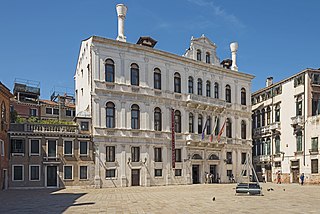
Palazzo Priuli Ruzzini Loredan, also called Palazzo Loredan at Campo Santa Maria Formosa, is a late 16th-century palace located at Campo Santa Maria Formosa in the Castello district of Venice, northern Italy, characterised by features of Renaissance and Baroque-style architecture on its façades.